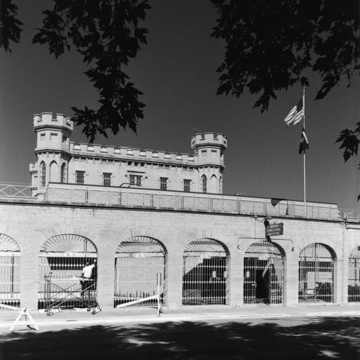Wisconsin’s first state prison is an excellent early example of the Auburn plan or system, which grew out of penal-reform debates in the United States and Europe in the late eighteenth and early nineteenth centuries. Reformers decried the prevailing unsanitary conditions and cruel punishments and called for cleaner prisons with individual cells and work and training programs. The reform impulse was humane, but the new prisons that resulted from them were not, by today’s standards.
Following a model developed at New York’s Auburn prison in the early nineteenth century, under which inmates slept in individual cells and performed silent group labor by day, prison authorities built tiers of small cells opening onto catwalks, six to ten feet from the building’s outer walls. The walls themselves framed expansive windows, stretching nearly all the way from floor to ceiling, to provide light and air to all the cells. The tiered blocks of cells became a distinctive, familiar characteristic of American prisons. Strict rules accorded with the philosophy that criminals first had to be broken before they could be reformed. Prisoners were to keep their eyes downcast and march in lock step. Communication between inmates was forbidden, as was fraternization between prisoners and guards. The idea that prisoners should serve their terms in silence waned in the early twentieth century, and the regimentation that characterized prisons of the previous century had all but disappeared by the 1950s, when the social sciences introduced new philosophies of rehabilitation.
The original Wisconsin State Prison complex, comprising the South Cell House (completed in 1855), the North Cell House (1868), the Main Building (1858), and the prison wall and guard towers (1858–1861), exemplifies the fortified Gothic Revival style employed for many prisons and adopted by most of the Auburn system institutions. They featured limestone walls, battlements, octagonal watchtowers with lancet windows, and heavy brackets below the cornice. The prisoners themselves, trained by local stonecutters, erected the buildings.
The extant portion of the historic prison encompasses two additional cell houses (1909 and 1914), a kitchen and dining room (1914), and an auto tag plant (1931). The binder twine factory built in 1909 has lost its historic appearance.


